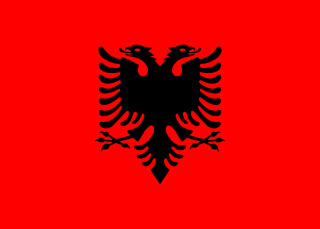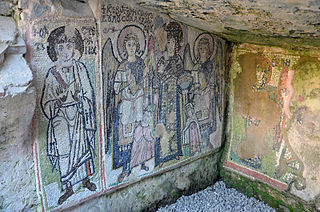
Albania, officially the Republic of Albania, is a country in Southeast Europe on the Adriatic and Ionian Sea within the Mediterranean Sea. It shares land borders with Montenegro to the northwest, Kosovo to the northeast, North Macedonia to the east, Greece to the south and maritime borders with Greece, Montenegro and Italy to the west.

The Albanians are an ethnic group native to the Balkan Peninsula and are identified by a common Albanian ancestry, culture, history and language. They primarily live in Albania, Kosovo, North Macedonia, Montenegro, Serbia as well as in Croatia, Greece, Italy and Turkey. They also constitute a diaspora with several communities established across Europe, the Americas and Oceania.

Tirana is the capital and largest city by area and population of the Republic of Albania. It is located in the center of Albania enclosed by mountains and hills with Mount Dajt elevating on the east and a slight valley on the northwest overlooking the Adriatic Sea in the distance. Due to its location at the Plain of Tirana and the close proximity to the Mediterranean Sea, the city is particularly influenced by a Mediterranean seasonal climate. It is among the wettest and sunniest cities in Europe, with 2,544 hours of sun per year.

This article is about the demographic features of the population of Albania, including population density, ethnicity, education level, health of the populace, economic status, religious affiliations and other aspects of the population. The demography of the Albania is monitored by the Institute of Statistics of Albania. The institute has performed demographic censuses since the 1924s. The latest census in Albania was performed in April 2011, and has been deemed as unreliable both within and outside Albania.

Durrës is the second most populous city of the Republic of Albania and the capital of the eponymous county and municipality. Situated on a flat plain on the southeastern shore of the Adriatic Sea, its climate is profoundly influenced by a Mediterranean seasonal climate.

Fier is a city and a municipality in Fier County in southwest Albania. The population of the municipality at the 2011 census was 120,655, and of the town proper 55,845.

The County of Durrës is one of the constituent counties in the northwest of Albania. It borders the counties of Dibër, Lezhë, Tirana and the Adriatic Sea.

Gjirokastër County is one of the 12 counties of Albania. The population at the 2011 census was 72,176, in an area of 2884 km². Its capital is the city Gjirokastër.

Shkodër County is a county in northwestern Albania, with the capital in Shkodër. The county spans 3,562 square kilometres (1,375 sq mi) and had a total population of 200,007 people as of 2020. The county borders on the counties of Lezhë, Kukës and the country of Montenegro. The county consists of five municipalities, including Fushë-Arrëz, Malësi e Madhe, Pukë, Shkodër and Vau i Dejës.

Tirana County, officially known as the County of Tirana, is a county in the Central Region of the Republic of Albania. It is the tenth largest by area and the most populous of the twelve counties, with more than 895,000 people within an area of 1,652 km2 (638 sq mi). The county borders on the Adriatic Sea to the west, the counties of Durrës to the northwest, Dibër to the northeast, Elbasan to the east and Fier to the southwest. It is divided into five municipalities, Tirana, Kamëz, Kavajë, Rrogozhinë and Vorë, with all of whom incorporate twenty-nine administrative units.
The most-common religion in Albania is Islam, the second-most-commonly religion is Christianity, however there are also many irreligious people. There are no official statistics regarding the number of practicing religious people per each religious group.

Albanians in Montenegro are an ethnic group in Montenegro of Albanian descent, which constitute 4.91% of Montenegro's total population. They are the largest non-Slavic ethnic group in Montenegro.

Albanian Americans are Americans of full or partial Albanian ancestry and heritage in the United States. They trace their ancestry to the territories with a large Albanian population in the Balkans among others to Albania, Italy, Kosovo, North Macedonia and Montenegro. They are adherents of different religions and are predominantly Muslims, Christians as well as Irreligious.

Tepelenë is a city and a municipality in Gjirokastër County, in the south of Albania. The town is located on the left bank of the Vjosa River, about three kilometres downstream from its union with the Drino.

Fierzë is a town and a former municipality in the Kukës County, northern Albania. At the 2015 local government reform it became a subdivision of the municipality Tropojë. Fierzë sits on both banks of the Drin, which here forms the boundary between Fushë-Arrëz and Tropojë.

Eastern Orthodoxy in Albania arrived in the area of contemporary Albania during the Roman period.
Doliće is a village in the municipality of Sjenica, Serbia. According to the 2002 census, the village has a population of 322 people.

Boroštica is a village in the municipality of Tutin, Serbia. According to the 2002 census, the village has a population of 379 people.
Irreligion, atheism and agnosticism are present among Albanians, along with the predominant faiths of Islam and Christianity. The majority of Albanians lead a secular life and reject religious considerations to shape or condition their way of life.















